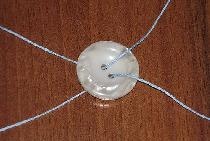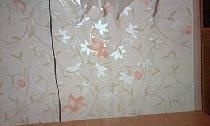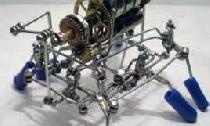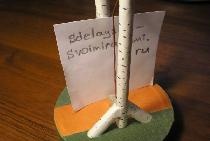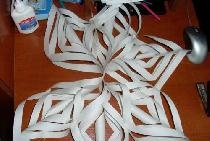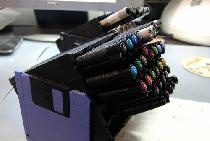How to make a car that runs on the ceiling
Recently, anti-gravity cars that ride on walls and ceilings have become quite popular. This is a rather interesting and unusual toy that works on the principle of a vacuum cleaner that sucks air from under the car. In this article we will talk about an experiment on how we made a similar machine at home using improvised materials.
We will need
- - Corrugated cardboard;
- - Motor (preferably fast);
- - 2 micromotors with gearbox;
- - unnecessary USB cables;
- - tact buttons;
- - AAA batteries and Li-ion batteries from the phone;
- - soldering iron, glue, etc.,
Making a car that runs on the ceiling
The first step in making a machine is to make slits in cardboard as in the picture. Using a ruler, make even bends and cut the cardboard in the marked places.
We lift the cut out part a little and glue small sides on the sides.
Cut out two small rectangles rounded on one side and glue on top.
Next, we make two small strips of plain paper and glue them onto the bottom of the machine; cut off the strips at the corners so that they do not cling to uneven surfaces. The future frame is ready.
From a disk or similar plastic, cut out a round blank the size of a 2-ruble coin and 4 blades 5x5mm. You should not make a large turbine, and there are many blades on the turbine (optimally 3 - 4 blades). Tests have shown that a large turbine spins more slowly due to the larger air intake, and the engine heats up 10 times more, and the holding effect is reduced significantly.
Use super glue to glue the blades to the circle as in the picture.
To prevent the blades from flying apart due to centrifugal force, we wrap them with thread and soak them with superglue.
From the lid we make a part as in the picture.
We apply glue to the cover and glue the engine of the future turbine.
We install the engine on the frame of the car and glue the turbine to the motor axis.
We make wheels from an ordinary lid. We put on a small elastic band for better grip and cut off the excess part of the lid.
We take two small motors with a gearbox (in our case from a Syma x5 quadcopter), you can also use micro servos like MG-90 and similar motors with a gearbox. It is important that they are small to save weight of the machine.
We bite off the protruding leg near the gear and glue the wheel from the cover to the gear with hot glue, making two such wheels.
We glue the engines with wheels to the body, it turned out as in the photo.
Due to the weight of the battery, we had to abandon controlling the machine using a television remote control and Arduino. Let's make wired control.
We will control using tact buttons according to this scheme. The advantages of this scheme are that you can use simple tact buttons for control, and 3 transmitting wires are enough to control two motors. The disadvantage is that you need 2 batteries and when moving in one direction, 2 motors are powered by one element, which reduces power.And we separately power the turbine engine from 2 lithium-ion batteries connected in series.
For convenience, we draw a diagram on the base of the remote control in a convenient form, and we will assemble it using a hinged installation.
We glue the clock buttons to the remote control, install two batteries, select and solder the wires of the required size.
After soldering, use a multimeter to check the remote control for functionality.
For the turbine, we glue two series-connected batteries to the bottom of the remote control, and for convenience we attach the start button to the edge of the remote control (the start button must be locked).
We rip out the old USB cable and remove the insulation to lighten the weight of the wire.
We solder 3 wires to the output on the remote control, and on the other side we solder them to the motors with wheels.
We also solder 2 wires for the turbine on the remote control and similarly for the engine with the turbine.
Let's check that the machine is working. Let's move on to the tests.
Conclusion
The machine works, but this is the first prototype and it has several disadvantages that still need to be improved. Unfortunately, it was not possible to make remote control from the remote control as intended, the machine fell due to the large weight of the batteries, and during the test it became clear that the gearboxes from the quadcopter were rather weak, and it was better to use a gearbox with a large gear ratio. A small modified engine with a gearbox from an MG-90 servo drive is good for these purposes. The toy turned out to be very unusual and noisy, it easily stays on the ceiling, you can happily ride on the ceiling, making circles. If you have ideas on how to improve this model, please let me know by leaving a comment...
Watch the video
The most interesting thing is of course in the video. Here you will clearly see how the machine quickly rushes along the ceiling of the apartment.
Similar master classes
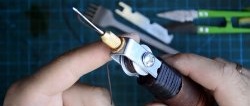
How to make a hand sewing machine for leather

Cotton candy at home
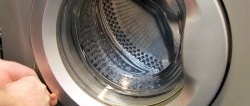
4 ways to open the washing machine door if it is jammed
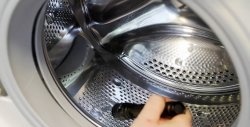
How to remove small objects caught in the washing machine from

We check the heating elements of the washing machine before and after use

Pincushion in the form of a sewing machine
Particularly interesting
Comments (0)


























